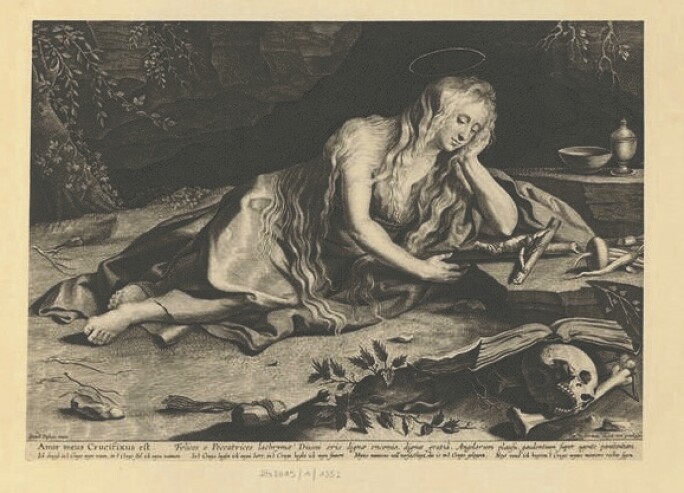Gerard Seghers painted this luminous Penitent Magdalene in the late 1620s, during his mature period, which was characterized by the increased influence of Peter Paul Rubens. A religious subject popular across Europe throughout the Renaissance and Baroque periods, the Magdalene is a symbol of the contemplative life, and her external beauty serves to emphasize the contrast between her former, sinful life and her devout faith. Following a specifically Northern tradition of depicting the Magdalene reclining and reading devotional literature, Seghers also added a thistle, a symbol of constancy in Dutch art, and a miniature crucifix, which may have been inspired by the artist’s membership in a Jesuit confraternity.
After becoming an independent master in Antwerp at age seventeen and joining the Jesuit Confraternity of the Society of Bachelors in 1611, Seghers spent the 1610s in Italy where he studied the works of the Caravaggisti, in particular Bartolomeo Manfredi. He returned to his native Antwerp as the Twelve Year Truce was ending, in 1620, and assisted Rubens with projects including the decoration of the Jesuit Church in 1621. As a result of his association with Rubens, Seghers gradually lightened his color palette and imbued his figures with more evanescent skin and flowing blonde hair, as seen here. The still life elements of the skull and book are rendered in great detail with strong light and shadow, as is characteristic of Seghers. The landscape on the other hand is broadly executed, suggesting that Seghers may have collaborated with Jan Wildens (1586 - 1653), who often painted landscapes in religious history paintings.
In conceiving this painting, Seghers had a strong iconographic tradition from which to draw. Since the medieval period, inspired by hagiography such as the Golden Legend, Mary Magdalene was believed to have retreated to St. Baume in southern France and lived as hermit in a cave for 30 years; by the 15th century a grotto in St. Baume had become a pilgrimage destination and a statue was erected of the Magdalene similarly reclining. After the Council of Trent, artists began to depict the saint less as an ascetic and more as a beautiful young woman, to emphasize that she rejected the physical world and devoted herself to a contemplative life. A century before Seghers’s painting, Adriaen Isenbrant had popularized the image of the semi-nude reclining Magdalene in the wilderness, and engravings of the subject proliferated through the eighteenth century. An engraving of the present painting by Lucas Vorsterman suggests that Seghers had a uniquely Jesuit interpretation of the subject, in which the Magdalene was especially devoted to the cross (fig. 1). The poem inscribed beneath Vosterman’s engraving translates to: “I bear my honor in the cross,/ I direct my love at the cross,/ I attach my heart to the cross,/ I attach my desires to the cross./ My love full of satisfaction,/ Is situated in the cross;/ Never have I found true victory/ of my love outside the cross.”1

1. See Wheelock 2005, pp. 226, 227, note 10.